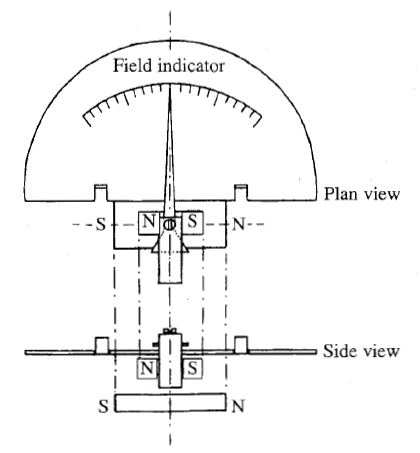Principles of Demagnetization
Ferrous materials usually retain some residual magnetism after the magnetizing current is shut off. The strength of the residual field depends on the permeability and retentivity of the material and the strength and direction of the magnetizing force. Complete demagnetization is difficult, if not impossible, to obtain. Thus, the demagnetization process is limited to reducing the residual field to an acceptable level. The basis for all demagnetization methods is the subjecting of the magnetized test object to the influence of a continuously reversing magnetic field that gradually reduces in strength, causing a corresponding reversal and reduction of the field in the test object.
Residual magnetism must be overcome by a slightly greater magnetic force. Residual magnetism is the amount of magnetism that a magnetic material retains after the magnetizing force is removed. Longitudinal and circular residual fields may exist simultaneously and may permit testing for discontinuities in several
directions during one test. Acceptable residual magnetism levels are generally stated in the work instructions or procedures applicable to the object being tested.
Reasons for requiring demagnetization are reduction in wear, or welding arc problems during later operations.
ALTERNATING CURRENT DEMAGNETIZATION
The most convenient method of demagnetization uses a specially built demagnetization coil. When such a coil is energized by passing the current through its windings, it induces a magnetic field in the test object placed in the coil. Because current direction reverses itself, the polarity of the induced magnetic field also reverses with each reversal of the current. As the test object is withdrawn from the coil, the magnetic field becomes weaker the further the test object is withdrawn from the coil.
Demagnetization is accomplished only if the test object is removed from the influence of the demagnetizing coil when the current is flowing. If the current is stopped when the test object is still in the influence of the magnetic field, the test object may still retain some magnetism.
DIRECT CURRENT DEMAGNETIZATION
Because the magnetic field produced by alternating current does not penetrate very deeply below the surface of the material, some test objects may be difficult to demagnetize completely. This is particularly true with large, heavy or unusually shaped test objects. Direct current can be used to demagnetize if provisions are made for controlling the amount of current and for reversing the direction of the current. Direct current demagnetization is usually more complete
and effective than alternating current demagnetization.
Some magnetic particle testing equipment is provided with capability for direct current demagnetization. Direct current demagnetization is preferably done on individual test objects rather than on groups of test objects.
To demagnetize with direct current, the test object is placed in a coil connected to a source of direct current. The current is adjusted to a value at least as great (but usually greater) than that initially used to magnetize the test object. A magnetizing shot is given at this initial value. The direction of the current is then reversed, the current value reduced and a magnetizing shot is given at the new value. This process of reversing and reducing the current is continued until the
lowest value is reached. For best results in demagnetization, the diameter of the
demagnetization coil should be just large enough to accommodate the test object. If demagnetization of a small test object is performed in a large coil, the test object should be placed close to the inside wall or corner of the coil, because the demagnetization force is strongest closer to the coil.
Efficiency of Demagnetization
For practical purposes, it is always correct to use a field indicator after performing demagnetization to determine that the residual field strength has been reduced to a desired level. The field indicator, shown in Figure, is a pocket sized device that measures the strength of a field against a set of small, enclosed permanent magnets that restricts the needle movement on a relative scale.
Whether to demagnetize a test object or not depends on a number of factors. Demagnetization is usually required if the following conditions apply.
1. A strong residual field might interfere with subsequent operations, such as welding or machining. Strong fields can flow the weld metal as it is deposited, or magnetic chips may cling to the cutting tool and interfere with machining.
2. The test object is a moving part in an assembly and a deposit of accumulated magnetized particles might cause wear.
3. Leakage fields might interfere with nearby instruments that work on magnetic principles; for example, compasses or indicators of various types.
Diagram of a typical magnetic field indicator.
4. Residual fields might interfere with proper cleaning of the test object.
5. The test object is to be magnetized at a lower magnetizing force in a different direction than the original or previous test.
6. Demagnetization is specified by procedural standards.
Demagnetization is usually not required or necessary if the following conditions apply.
1 . If the test object is made of low carbon steel or iron where retentivity is low.
2. If the test object is to be heat treated above its curie point after the magnetic particle test.
3. If the test object is to be magnetized again in another direction at the same or higher amperage.
Batch demagnetization is the demagnetization of many small test
objects simultaneously. Batch demagnetization of small test objects
may be accomplished using the following methods.
1. Thermally treating the test objects above its curie point.
2. Vibratory treatment, if applicable.
